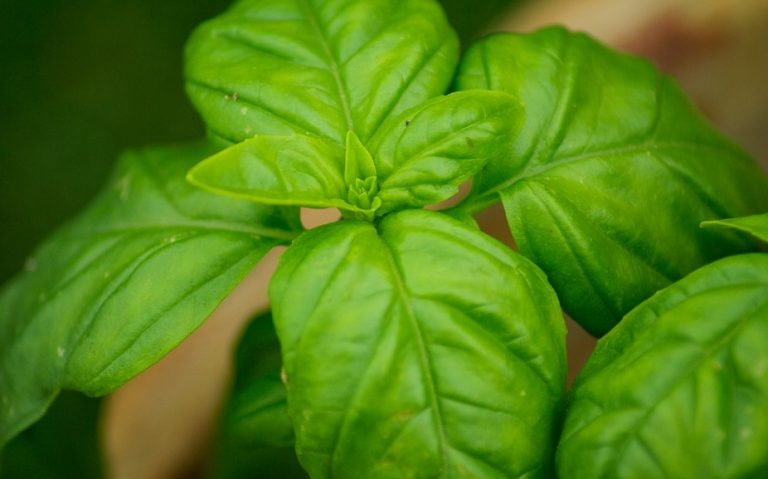Growing Basil Indoors is quite simple (if it’s done correctly). How you grow your basil will depend on your exact needs and how much money and time you want to invest.
If you have plumerias growing in your yard, then you will also want to check out our article on how to raise healthy plumerias.

The Simplest Method – Traditional Soil
This is easy enough – buy a basil plant from a local grocery store. Keep a plate underneath your basil plant to catch any water that may drain out of it.
Light: Give your basil plant at least four hours of full sun. If possible try to keep it away from drafty windows where the plant might become too cold (try to keep it around 70 F)
Soil: If you will be planting from seed, make sure the potting mix is loose and well-drained
Water: Water regularly, but also do not water too much.
Water whenever you start to see your basil plant beginning to wilt.
Fertilizer: Use a weak fertilizer weekly.
Amount of Product: Fair amount – will likely be sufficient if you are only occasionally using the basil as a garnish.

High Yield, Explosive Flavor Method – Hydroponics – Year Round Basil
If you need larger amounts of basil, such as if you like to make pesto, you’ll want to use the hydroponic method of growing basil with artificial grow lights. This helps the plants grow significantly faster and tends to make the flavor more intense.
With this setup, you will also have a truly year-round setup as you will not be reliant on the sun and can also place the basil away from drafty windows. The artificial grow lights are quite bright, so you will want a separate room to put your plants in.
Hydroponic Aerogarden Grow Kit
We recommend buying an Aerogarden and using the tips below:
With the Aerogarden above, you will have 6 slots to grow plants. The ideal would be to always have 2 mature basil growing with young basil plants growing in the other 4 spaces. That way, when the older basil plants’ roots get too large, you simply rotate in the more immature basil plants that are ready to produce more basil.
The first time you use the Aerogarden, you can grow one or all of the different pods of herbs for the sake of learning how to use it. Pay particular attention to the basil though, as this is obviously the most important herb in the pack for your purposes.
You will notice as you grow from seed that the process from growing from seed can take a while as the roots of the plant have to establish. We will get around this step in the steps to come.
Make sure to prune your basil relatively frequently to make it thicker rather than purely growing vertically.
If you have trees growing on your property, make sure to use our navigation above to find our different articles for caring for different trees. For instance, we have an article on taking care of Indian Laurel Fig Trees.
Clone your Basil
When your basil has grown nice and tall, we recommend that you start making clones of your basil plant to allow more immature basil plants to start to develop as you continue to harvest the current adult plant for usage.
Cloning a plant allows you to bypass the slow process of growing from seed. It still takes time, but much less so.
Step 1 – Prepare a new grow plug
Take out one of your other aerogarden plants and remove the plant completely from the plastic housing. Keep the plastic housing.
Buy aerogarden replacement grow plugs. Cut the plug lengthwise so that it forms a slit in the grow plug (see the Youtube video below – not produced by this site – for a visual example)
Step 2 – Cut your adult basil plant
Get a cutting from your adult basil plant. To do this, you will want to cut off a portion of your basil plant that includes three nodes.
Then, cut off the leaves on the bottom two nodes and cut big leaves in half. Cut at a 45 degree angle across the bottom-most node.
Step 3 – Place in Aerogarden
Put the cutting into the slit you had created in step 1, then put the plug in the Aerogarden plastic housing you kept.
Put the pod in the Aerogarden and simply wait. Within about a week, you will suddenly see large healthy root emerge from the cutting/grow plug.
Use these techniques to have a constant and plentiful supply of basil on hand at all times. You can be ready to make pesto at any time or feel less guilty about using basil as a finishing garnish. If you have too much, you can even freeze the basil to save it for future usage.

